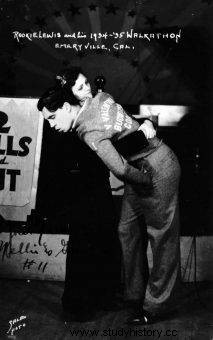Martha Graham, an American dancer and educator, once said that "dancing is a reflection of our body, sometimes play, sometimes pain." And there is something to it. During the Great Depression in the United States, people who often danced until they dropped became a symbol of desperation.
In the 1920s, dance marathons began to gain popularity. The real boom in this form of entertainment began in 1923, when a certain Alma Cummings danced continuously for 27 hours with six different partners . At first, breaking this, and then breaking new records, was the only and greatest motivation for the participants. Time and harsh reality changed that.
Dance, dance until you are out of breath
The phenomenon of marathons was that everyone could take part in them. During the long stay on the dance floor, no one looked at the style, grace or purely technical skills of the dancers. In fact, the most important thing was endurance. The differences were mainly visible in the organizational field and in the "rules of the game", which were not uniform. The only rule linking each contest was the one preventing participants from falling asleep or fainting . Although there were exceptions to it:in some marathons, after a certain, predetermined time, one person in the pair could go for a few minutes' nap, but the other had to continue dancing. The dance floor could be left - temporarily, of course, and not too often - only in the event of a physiological need or medical consultation.
The music accompanying the participants was varied. The lively and energetic pieces were mixed with the calm ones. In such rhythms, those willing could run on the dance floor for several days. Or longer, as several-week-long marathons were nothing special . It is also worth mentioning that they were organized all over the United States and over time they became something of a traveling circus.
In October 1929, the Great Depression broke out. People lost their jobs and thus their livelihoods. Everyone was looking for money, everywhere. This fact was carefully used. At the turn of the 1920s and 1930s, organizers of dance marathons offered participants prizes. The most popular were contests with money to be won, often counted in thousands of dollars . How were the organizers able to get them in such difficult times? Funds were provided by the public. The events lasted a long time and many people could watch them. For (most often) 25 cents anyone could watch them as long as they wanted. And there was a lot to see!

The only common rule for dance marathons was that participants cannot fall asleep or pass out while dancing.
The real show started when the first dancers sank to the mosaic, although not everyone did it after one or two days. Mike Ritov and Edith Boudreaux, who danced from August 29, 1930 to April 1, 1931, went down in history only for the breaks permitted by the regulations. For their performance, they collected $ 2,000, which in today's value of the American currency is equivalent to $ 28,000. Was it worth it? Mike and Edith would probably say yes, but the opponents of the marathons, and there were plenty of them, would definitely nod their heads no.
Don't dance, it's too dangerous
Part of the medical community belonged to the "anti-marathon" movement. The more conscious doctors emphasized that this type of exercise has nothing to do with health and can lead to irreversible changes in the body. Due to the lack of sleep, the participants could suffer from various types of pains. They were familiar with blisters on their feet, sprains, strains, but also more serious disorders such as hysteria, delirium and even coma . Suffice it to say that a certain Homer Morehouse fell on the dance floor after 87 hours of continuous dancing, because his heart could not bear the load. Reanimation did not help. Most likely, he was not the only daredevil to die during the marathon. Unfortunately, the exact number of similar deaths will not be known, because the organizers did not keep relevant documentation.

In October 1929, the Great Depression broke out. People lost their jobs and thus their livelihoods. Everyone was looking for money, everywhere. This fact was carefully used.
Other critics of the dance marathons were cinema owners who, as you can guess, were losing customers. The clergy did not like the way the participants danced with each other, and the female groups noted the humiliation that was served to each other by dancers fighting for money.
The turning point in this story was the moment when a broken-hearted woman tried to commit suicide with her 19-hour dance performance that finally gave 5th place. . The situation took place in Seattle in 1928. Almost immediately, the city authorities introduced a ban on organizing dance marathons. Several years passed before the rest of America followed in Seattle. In the times of the Great Depression, the rulers had more important matters on their heads.
Currently, dance marathons are often held as part of charity events. Properly secured, they do not last for weeks, and the money collected for it goes to the needy. For example, the Penn State Dance Marathon commonly known as THON, the 46-hour dance marathon held every February at Pennsylvania State University since 1977, has raised over $ 155 million to fight cancer among children.
Bibliography:
Paula Becker, Dance Marathons of the 1920s and 1930s https://historylink.org/File/5534https://historylink.org/File/5534 (access:02/10/2021)
https://dance.lovetoknow.com/Dance_Marathons (accessed:02/10/2021)
https://www.jestpozytywnie.pl/stawka-bylo-ich-zycie/ (accessed:02/10/2021)
